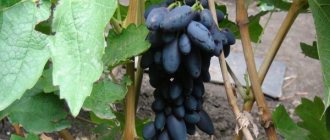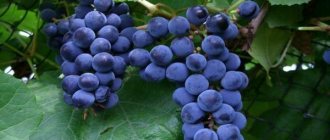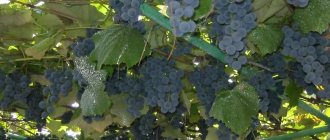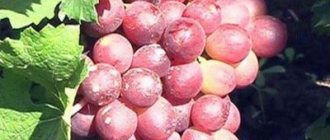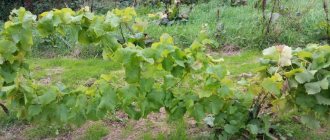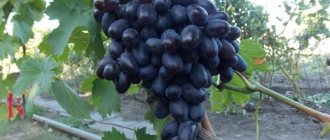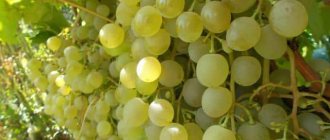Fruits and berries » Grapes
0
801
Article rating
Kira Stoletova
Today, hybrid grape varieties are becoming increasingly popular because they taste better and are also resistant to diseases and frost. Producer grapes, or Producer Seedling grapes, are valued for their early ripening and taste.
Description of the grape variety Producer
Botanical description of the variety
Characteristics of the Producer grape vine:
It grows up to 6-8 meters during the season. The vine is capable of forming 15 or more shoots per season. The leaves are medium-sized, dark green, the edges are carved with pronounced deep teeth. The vine manages to ripen very well over the season.
Important! According to the description of the variety, the “Producer” grapes belong to the same-sex flowering type; they have only female flowers. That is why it is usually planted so that there is a grape bush with a bisexual type of flowering nearby. If you follow this simple rule, then the variety will have virtually no peas.
The Producer grapes are an early, table, consistently productive, stress-resistant variety. Produces up to 35 kilograms of harvest from one bush. In cold winter conditions, it is imperative to cover this variety. Withstands short-term frosts of -24 0C without shelter.
Characteristics of the bunch:
The bunch of “Producer” grapes is beautiful, conical in shape, of moderate density, reaching 25-30 centimeters in length. Depending on the strength of the bush, it weighs 0.8-1.5 kilograms. The berries in a cluster of round, ellipsoidal shape with a slightly pointed end reach a weight of 10-15 grams. The color of the berries is very beautiful, white-green. The length is 3 centimeters, the width of the berry reaches 2-2.5 centimeters. The bunch is loose. The berries in the bunch do not crush themselves. They are not prone to cracking and are difficult to tear off from the bunch, even during long-term storage.
Taste characteristics:
“Producer” has large berries that are characterized by high sugar accumulation and crispy pulp. They have a regular, non-nutmeg, fruity aroma. The taste is a bit like a juicy pear. The seeds are quite large, but there are very few of them and can be chewed without much effort. The skin covering the pulp is thin and is practically not felt in the mouth.
Since “Producer” is a table grape variety, it is consumed mainly fresh. However, this variety also makes excellent preparations; it is pickled, compotes, juices, jams, etc. are made.
Growing a plant
To get a good yield, you need to prune the bush every fall. With the help of pruning, a large amount of useful substances enters the bush. Pruning is carried out as the pagons grow; be sure to leave 6-8 eyes if the bush is tall, 4-5 eyes if it is medium-sized.
Planting in the soil
Seedlings should be planted both in autumn and spring. This variety does not tolerate drafts, so it is worth taking care of the fence.
In order for the plant to grow and develop, it must be planted correctly:
- a couple of days before planting, prepare the pit;
- Fill the hole halfway with fertilizer and soil;
- wait until the soil settles;
- keep the seedling in water for a day;
- plant;
- water;
- mulch the soil.
Plant care
When caring for a plant, it is important to take into account that it needs regular watering; if it is not enough, the bush will not take on the correct shape and the harvest will be low. The plant requires fertilizers; the bulk is added to the soil during mulching. In order for it to produce high yields, pruning should be done.
It is better to plant on the south side of buildings to provide the bush with good lighting.
This variety is resistant to frost down to -23°C, but it is better to provide it with reliable shelter for the winter. For small seedlings, plastic bottles are suitable, for large plants - film, while creating a tunnel at the top.
Fertilizer
Useful components, first of all, enter the plant during mulching. Humus, moss, and old sawdust are used. This process takes place to a depth of 3 cm. Potassium and phosphate fertilizers are also used for feeding.
Watering
The plant needs to be watered as needed
Producer grapes are unpretentious in watering. Heavy watering during the ripening period can cause the berries to begin to crack. During the dry summer period, you need to monitor the soil; if it dries out, be sure to water it. Also, abundant watering is required before the plant begins to bloom, as well as after flowering. Diseases and pests
The grape variety Seedling Producer is resistant to diseases and pests. But if there are ones to which he is susceptible. Pests include spider mites and leaf rollers. Diseases – mildew, oidium, anthracnose.
Article on the topic: What is needed for a plantation - grapes
Commercial qualities:
“Producer” grapes ripen very early: 105-115 days from the beginning of the growing season, and already in mid-August a fully ripened harvest can be harvested. The marketability of the variety is high. The clusters can hang on the bushes for a long time without losing their commercial qualities: the berries do not crack or fall off, the pulp acquires a marmalade consistency, and the taste is very pleasant.
A general description of the Producer grape variety is presented in the table:
| Variety | name "Producer" |
| Frost resistance | -23-24′ needs to be covered for the winter |
| Disease resistance | 5-7 points |
| Pea planting | probably in the absence of a bush planted nearby with a bisexual type of flowering |
| Sugar content | High up to 20% |
| Aroma | regular, with fruity notes |
| Raw materials for wine | No |
| Consumed raw | yes, table variety |
| Transportable properties | good |
| Craving for the earth | Fertile sandy soils |
| Productivity | high, more than 35 kg with 5m2 |
| Color | white - green |
| Berry size | Length about 3 and width 2-2.5 centimeters |
| Berry shape/berry weight | It has an ovoid shape, the weight of the berries is 8-12 grams |
Morbidity and preventive measures
The Producer grapes are highly resistant to many major vine diseases. However, for the purpose of prevention, it must be treated against mildew and oidium.
| Diseases | Sustainability |
| Downy mildew (mildew) | High - 7 points |
| Oidium | High - 5-6 points |
| Gray rot | High – 6 points |
As has already been said about this grape variety, the Producer grapes are relatively resistant to the most common vine diseases. Most often, preventative spraying is sufficient to obtain a healthy harvest. For preventive purposes and for the treatment of oidium, the modern drug “Folkon” has proven itself well; the treatment with it is repeated once or twice: first, the drug is used immediately after bud break, and the treatment is repeated a second time after flowering.
Spraying with copper and iron sulfate preparations is effective against mildew and pests, both before and after covering the vine, and after each rain. Treatment is also carried out with the preparations “Bi-58” together with “Horus” at the stage of the first 4-6 leaves and with a mixture of “Ridomil Gold” with “Topaz” and “Aktelik” at the stage of the appearance of pea-sized berries.
Disease Control
Mildew disease manifests itself as pale green and yellowish transparent oil spots on the leaves, brown spots on the shoots and ridges. The inflorescences and berries darken and fall off. The development of the disease will be stopped by the application of potassium and phosphorus fertilizers, foliar feeding (iron, zinc, boron). For treatment, spraying with fungicides is used.
Powdery mildew is also called powdery mildew. Caused by a fungus, it destroys the plant, preventing it from ripening. Comprehensive measures are taken to treat the disease. Chemical preparations Topaz, Bayet, Skor are used before harvesting. Afterwards, Fundazol and copper chloride are used.
Anthracnose is a disease that occurs due to a fungus from the class Ascomycetes. It affects all green parts of the plant. Young tissues are most susceptible to this disease. Anthracnose appears on leaves as small brown spots with a white border. As the disease progresses, they enlarge and merge. On the shoots there are brown spots with a purple border. The shoots will become brittle and break. For treatment, a complex of measures is used: chemical, agrotechnical. The bushes are ventilated, dug up, the affected parts are cut and burned, and then chemicals are used.
Pest Control
Spider mites infect the lower part of leaves, forming white-yellow spots. Treat with acaricides 3 times with intervals of 7-10 days.
The drug Omite will save predatory mites, they will destroy the rest, which will speed up the treatment period.
The leaf roller damages buds, flowers and berries. Damaged parts begin to rot, dry out and fall off. It is necessary to carefully remove damaged parts of the plant to prevent pests from spreading. To save the bush, three treatments are carried out: Fozalon, Ambush, Sumicidin.
How to prune vines correctly
“Producer” grapes are pruned at a convenient time on a dormant vine (February-March), when severe frosts (below -25 degrees) are no longer expected. Since the variety is medium-sized, the pruning is done medium-sized, with 4 and 8 buds. However, it has been noticed that even with long pruning, the grapes produce excellent yields. About 40-50 eyes are left on the bush, depending on the condition and age of the vine.
“Producer” bushes can reproduce in all ways: seeds, cuttings, layering and seedlings. The seeds have good germination, but due to the fact that there are few of them in the berry (2-3 seeds), this type of propagation is used least often. “Producer” scions grow and bear fruit very well on a strong vine of another variety. Grafted bushes give an excellent harvest the next year.
How to get super-yields of grapes without costs
Feeding bushes is very important for getting a good harvest. With proper and regular care of the bushes in favorable years, it is easy to obtain super-yields without special expenses.
- Manure and bird droppings are excellent organic fertilizers for this plant.
- Organic fertilizers are applied to the soil in the fall, a week before plowing the vineyard. They enrich the plant during the active growth of the bush, providing it with nitrogen components.
- Mineral fertilizers containing nitrogen components (urea, various nitrates, urea) are applied to the soil during irrigation. These fertilizers affect the growth and development of bushes. But such feeding should be used with caution, without violating the dosage specified in the recommendations for the drugs. Stop fertilizing with mineral fertilizers by mid-summer, as the vine does not ripen well under their influence.
- Phosphorus fertilizers (superphosphate) are applied to the soil in late autumn before plowing once every two to three years. Phosphorus is needed for the development of all parts of the grapes and is absorbed from the soil in the quantities required by the vine.
- Potash fertilizers are essential for grapes. They are applied throughout the entire period of growth and ripening of the vine from spring to autumn. Potassium affects shoot growth, ripening and growth of berries, as well as the accumulation of sugars.
- Micro- and macroelements are used as foliar fertilizer. If the soil is adequately enriched with them, then this type of fertilizing is not needed. However, Plantacol, Microplant and others are products that strengthen plants and promote better ripening of berries. Such fertilizers have proven themselves well in combination with fungicides.
Note!
- To make the clusters larger, they can be normalized, leaving only no more than three strong clusters, while the rest are cut off during pruning of the vine.
- Grape bushes need to be watered at least once a month, starting in May. If the summer is dry, watering should be done more frequently (once every 2-3 weeks).
- To prevent crusts from forming on the ground after watering, the soil is covered with mulch with approximately a layer of 5-8 cm, which protects the soil from drying out and also additionally enriches the soil with microelements.
How to care for a Producer?
When caring for Producer grapes, observe the following features:
- This variety loves moisture. Without a sufficient amount of it, the bush will not have the opportunity to fully take shape. Otherwise the harvest will lose its richness. The variety needs to be watered abundantly before it begins to bloom, as well as immediately after. It is necessary to monitor the normal level of humidity, especially during the dry summer period.
- It is very important to provide grapes with fertilizers. Partial fertilizing will enter the plant through the soil, when it is mulched. When mulching, use humus, moss, old sawdust that has changed its color to dark sawdust is also suitable. Mulch the soil to about three centimeters deep.
- In each autumn period, it is important to prune the bush so that it bears a rich harvest. Thanks to this, much more useful substances enter the bush. Before pruning, pay attention to how much the pagonians have begun to grow. If the bush is very tall, then trim it to 6 to 8 pagons. If it is a bush with average ripening, 4-5 eyes are destroyed on it. In this way, the correct shape of the bush is created.
- Producer is a frost-resistant variety, but it feels even better under cover. Small seedlings especially need this. They need to be covered with cut plastic bottles. The bush in its adult form is covered with oilcloth, so that at the top it turns out to be something like a tunnel.
Related article: Oli coca - grape variety

